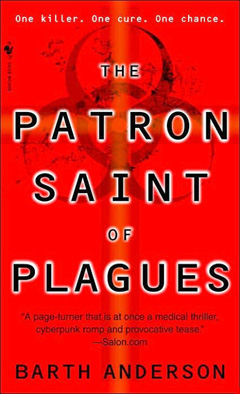
|  |  |  Entertainment | Books | May 2009 Entertainment | Books | May 2009  
Mexico's Swine Flu Epidemic - Is the Truth Stranger Than Fiction?
 Ed Hutmacher - MexicoBookClub.com Ed Hutmacher - MexicoBookClub.com


| | For more information on these or other books with Mexico-related themes, please visit MexicoBookClub.com. |  |
A few years ago, Barth Anderson wrote a biotech thriller about a mysterious virus that threatened to decimate the population of Mexico and spread to the rest of the world. As science fiction goes, The Patron Saint of Plagues delivers the kind of stuff readers expect from this genre of literature: a strange, apocalyptic world realistic enough to make us wonder, or worry, if such a future is our fate.

Anderson surely didn't expect his book to foreshadow today's all-too-real flu epidemic in Mexico. Nor do we need science fiction to warn us that a virulent outbreak can happen. Influenza pandemics, or the threat of them, have set off waves of panic ever since 1918, when 100 million people around the world died from the illness. Hardly a week or month goes by nowadays when we don't hear some new and disturbing news about a weird strain of pig or bird flu poised to wreak havoc on humanity.

Along with the H1N1 strain of swine flu now traipsing through Mexico and other parts of the world, there are other recent incidents of deadly viral outbreaks. In 2003, the continent-jumping SARS disease killed nearly 800 people.

The sporadic but no less deadly avian flu bug is thought to have killed some 300 people over the last decade. Nor should we ignore the fearsome Ebola virus, which was about to burn through the suburbs of Washington D.C. in 1989 before a SWAT team of soldiers and scientists wearing biohazard space suits prevented an outbreak. Ebola kills nine out of ten of its victims so quickly and gruesomely that even the biohazard experts were terrified.

The likelihood of a devastating epidemic has been a staple of science fiction books and disaster movies for years, beginning with Michael Crichton's 1971 The Andromeda Strain, a hair-raising tale about a deadly extraterrestrial microorganism that rapidly and fatally clots human blood. The real-world science Crichton used to buttress his fictional story made the idea of an alien “Andromeda” virus more believable. And frightening.

So, too, does Anderson press our hot-zone buttons by incorporating imaginable scenarios into The Patron Saint of Plagues. Imagine a near future, second-rate United States in which the economy has all but collapsed because a virus has decimated crops and agricultural production.

Imagine an ascendant Mexico in which a new, telepathic computer network lifts the country to first-world status. Imagine Mexico ruled by a ruthless religious sect determined to recapture territorial losses along the northern border and control the indigenous underclass.

Imagine a populist uprising led by a prophetic new-age spiritual leader who seeks to rescue her people. Imagine another virus, a biologically engineered plague purposefully aimed at tens of millions of humans but now threatens to run amok and overwhelm all attempts to contain it. Imagine a gringo germ jockey, a virus hunter smuggled into Mexico to save the day.

Science fiction leaves a lot to the imagination, but wading through all the possibilities is part of the thrill.

What's more, the future world painted by Anderson is a believable extension on the current state of affairs between the U.S. and Mexico: the shared border disintegrates into anarchy; governments turn tyrannically corrupt; cultural and racial tensions escalate to a fevered pitch.

The technology that's interlaced throughout the story is not so futuristic that it couldn't be accomplished in the near future. But the most interesting parts of the story is the real-world medical descriptions of the mysterious plague and the way the hero works to handle it.

By and large, we've grown accustomed to coping with common maladies and run-of-the-mill flu attacks, even exotic infections like dengue fever. Our experience of having already “been there and done that” and confidence in miracle vaccines has inured us to the potentially dangerous consequences of infections.

And yet, mysterious viruses and strange bacteria continue to terrify us, not simply because we know they can be lethal. It's what we don't know that scares the bejesus out of us. And when a virulent outbreak does take place, like the mutated H1N1 swine flu virus in Mexico, all hell can break loose. In that regard, truth and fiction aren't so far afield.

Ed Hutmacher is Editor in Chief of Mexico Book Club. For more information on books with Mexico-related themes, please visit the website at MexicoBookClub.com. |

 |
|  |



